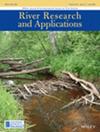Biogeomorphological response to river restoration of a suburban river with large wood: Creating a restoration vision and cost-effectively monitoring the response trajectory using the citizen science MoRPh survey
IF 1.9
4区 环境科学与生态学
Q4 ENVIRONMENTAL SCIENCES
引用次数: 0
Abstract
Biogeomorphological responses to river restoration are rarely reported. Despite a transition in the emphasis and priorities of river management over the last 40 years from controlling river channel forms and processes to restoring and supporting natural processes, forms and functions, remarkably little information is available on project outcomes. Here, using the example of Beverley Brook within Wimbledon Common, Greater London, UK, we illustrate how standardised detailed monitoring information can be assembled at a very low cost using the citizen science MoRPh survey and we demonstrate the importance of having a pre-project vision of likely outcomes that can be tracked by the monitoring programme. We show how a pre-project and five post-project surveys undertaken over 4 years according to a before-after-control-impact (BACI) design provides scientifically robust data. Analysis of the survey data quantifies the nature, abundance and spatial distribution of restoration interventions, the immediate responses to those interventions, and the ensuing trajectory of biogeomorphological adjustments. Changes in the persistence, size, position, abundance and evolution of habitats reveal the degree to which the restoration achieved the pre-project biogeomorphological vision and why the recovery trajectory progressed at the observed rate and to the observed end point over 4 years. Our approach has enormous potential for monitoring the outcomes of river interventions. Whilst our project was limited in its spatial scale and focus on physical habitats, we suggest how these limitations could be overcome whilst still containing costs.生物地貌学对一条郊区大木河流修复的反应:利用公民科学 MoRPh 调查创建修复愿景并以具有成本效益的方式监测响应轨迹
有关河流恢复后的生物地貌反应的报道很少。尽管在过去 40 年里,河流管理的重点和优先事项从控制河道形态和过程转变为恢复和支持自然过程、形态和功能,但有关项目成果的信息却少得可怜。在此,我们以英国大伦敦地区温布尔登公地的贝弗利溪为例,说明如何利用公民科学 MoRPh 调查,以极低的成本收集标准化的详细监测信息,并证明在项目实施前对监测计划可跟踪的可能成果进行展望的重要性。我们展示了如何根据 "控制前-控制后-影响"(BACI)设计进行为期 4 年的项目前调查和 5 次项目后调查,从而提供科学可靠的数据。对调查数据的分析量化了恢复干预措施的性质、丰度和空间分布,对这些干预措施的直接反应,以及随后的生物地貌调整轨迹。栖息地在持续性、大小、位置、丰度和演变方面的变化揭示了恢复在多大程度上实现了项目前的生物地貌愿景,以及为什么恢复轨迹以观察到的速度发展,并在 4 年内达到观察到的终点。我们的方法在监测河流干预成果方面具有巨大潜力。虽然我们的项目在空间规模和对物理栖息地的关注方面受到限制,但我们建议如何在控制成本的同时克服这些限制。
本文章由计算机程序翻译,如有差异,请以英文原文为准。
求助全文
约1分钟内获得全文
求助全文
来源期刊

River Research and Applications
环境科学-环境科学
CiteScore
4.60
自引率
9.10%
发文量
158
审稿时长
6 months
期刊介绍:
River Research and Applications , previously published as Regulated Rivers: Research and Management (1987-2001), is an international journal dedicated to the promotion of basic and applied scientific research on rivers. The journal publishes original scientific and technical papers on biological, ecological, geomorphological, hydrological, engineering and geographical aspects related to rivers in both the developed and developing world. Papers showing how basic studies and new science can be of use in applied problems associated with river management, regulation and restoration are encouraged as is interdisciplinary research concerned directly or indirectly with river management problems.
 求助内容:
求助内容: 应助结果提醒方式:
应助结果提醒方式:


